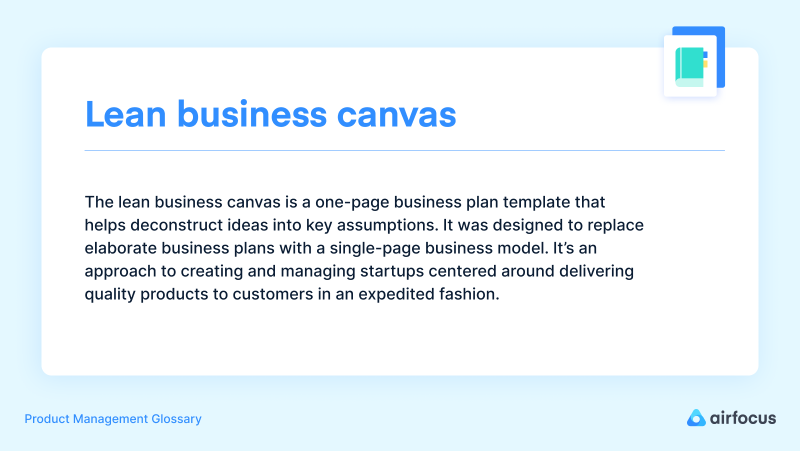Lean Business Canvas
What is a lean business canvas?
Lean Business Canvas
The lean business canvas is a one-page business plan template that helps deconstruct ideas into key assumptions. It was designed to replace elaborate business plans with a single-page business model. It’s an approach to creating and managing startups centered around delivering quality products to customers in an expedited fashion.
Businesses can use a lean canvas to evaluate business opportunities without building a full business plan. You can also use a lean business canvas to explore new products or feature ideas before development starts.
Origins of lean business canvas
The lean business canvas is an adaptation of Alex Osterwalder’s business model canvas that has been optimized for lean startups. It was created in 2010 by Ash Maurya to help startups address customer problems and their solutions and deliver them to customer segments through a unique value proposition.
Why should product managers use a lean business canvas?
The lean business canvas has become an excellent tool for product managers as it offers a range of benefits to make product development easier.
Lean canvases are quick and easy to create, perfect for a fast-paced or agile business. They’re an actionable approach to validating ideas to see if they fit the overall business goals. This helps put ideas into perspective to ensure new products help drive business growth.
Because the lean canvas is just a single page, it clearly lays out your plans and is easy to share. This is essential for securing buy-in from your stakeholders.
Product managers can use a lean canvas to increase focus on specific features or items. It allows teams to focus on one problem at a time, creating a systematic process of working through ideas while examining those ideas from every possible angle.
When to use a lean canvas in product development
There are many opportunities to use the lean canvas in the product development cycle, including:
When you want to visualize an idea to uncover the bigger picture
When you need to brainstorm new ideas
When you want to visualize a competitive advantage and conduct market analysis
When you need to maintain focus on specific problems
When your priority is to create a product that solves a particular problem
When you develop a new product
The 9 components of a lean business canvas with examples
The lean business canvas is made up of 9 elements:
1. Problem - Outline the problem your product aims to solve or a gap in the market you want to pursue.
2. Customer segments - Who are the people you’re solving this problem for?
3. Unique value proposition - What makes your product stand out from the competition?
4. Solution - How will your product solve your problem?
5. Channels - How will you reach the right audience?
6. Revenue streams - Which revenue model will you use, and what expectations do you have regarding revenue from this product?
7. Cost structure - Outline the associated costs with pursuing this idea, including customer acquisition, distribution, resources, and labor.
8. Key metrics - How will you measure success?
9. Unfair advantage - What can you offer that your competition cannot?

General FAQ

Glossary categories
Experience the new way of doing product management

Experience the new way of doing product management








